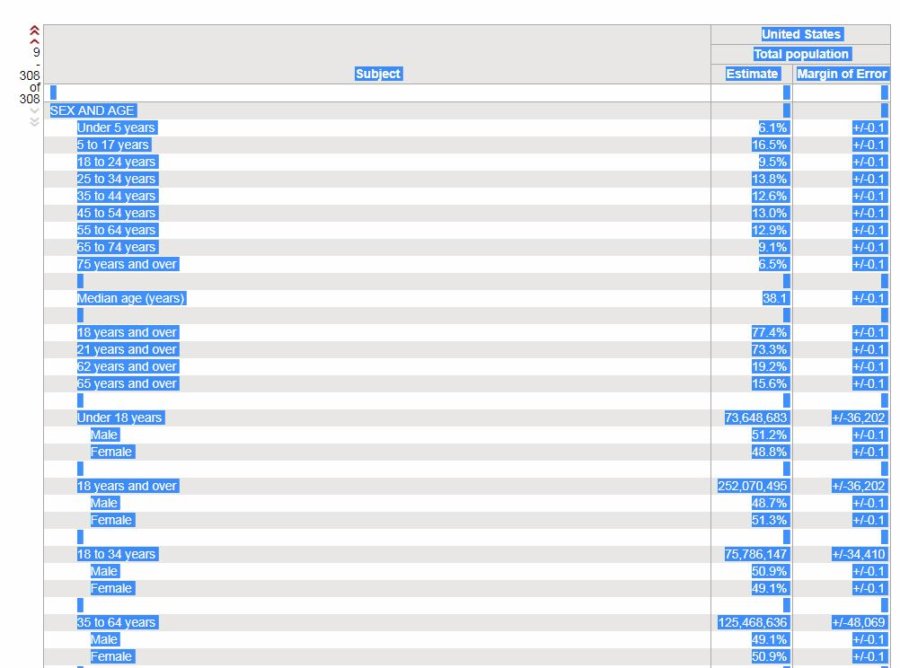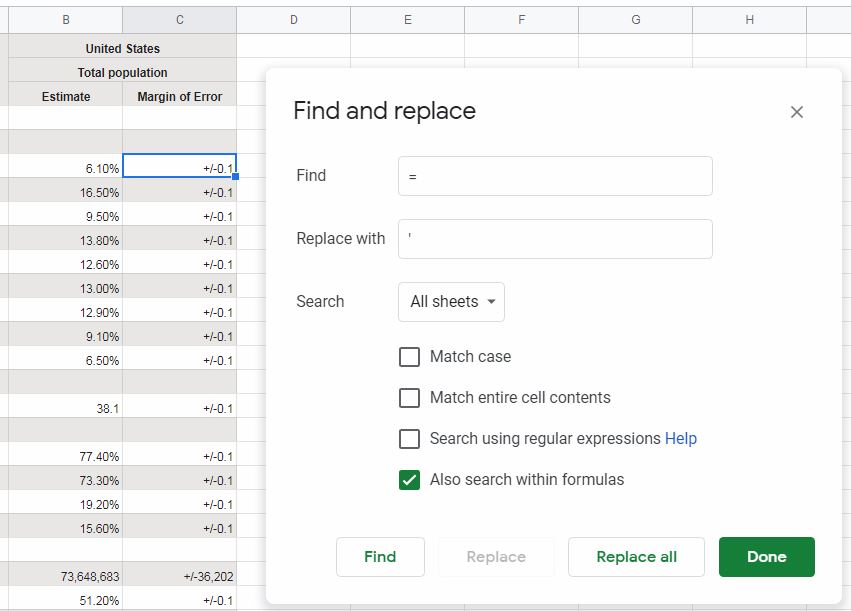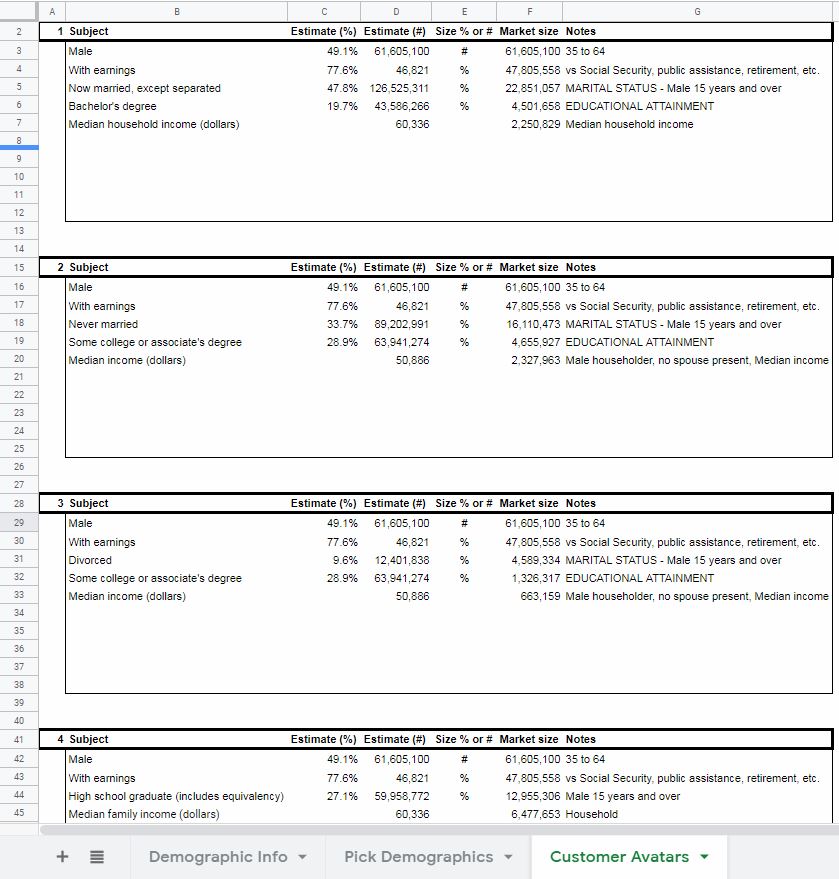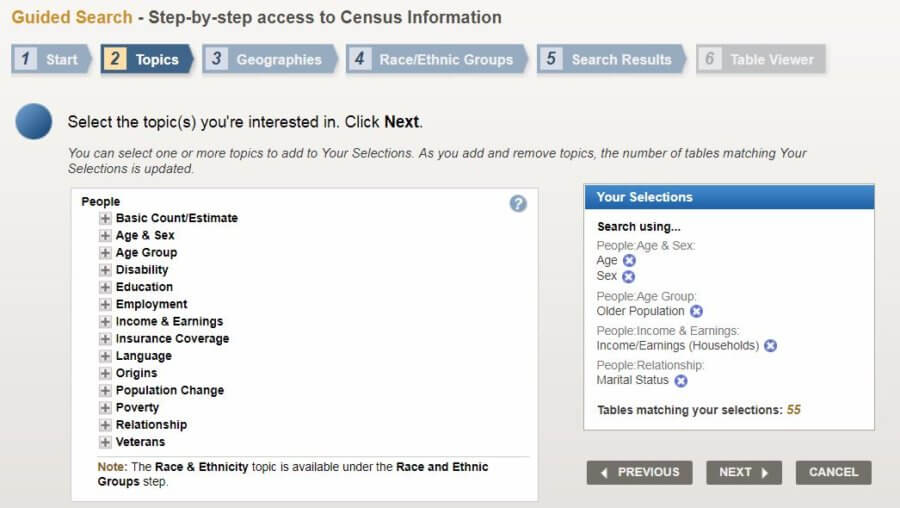Sorting through demographic information is one of the first steps in doing market research and competitive analysis. This is stuff you’ll need to know in order to prepare an effective business plan. Without this information, you, as a founder, don’t know if there is a sufficient market to support your business. You will also be starting off at a disadvantage when planning other aspects of your business.
**Note: this business plan demographics guide was written just before the Census Bureau changed its primary portal for data from the American FactFinder to Data.Census.Gov.
Download a free copy of the workbook used in this post
Complete the form below and click Submit.
Upon email confirmation, the workbook will open in a new tab.
Keep in mind that this workbook is only designed to work with table S0201, Selected Population Profile in the United States. Any other table might not be in the correct format.
About these posts
This series of posts was written to convey my take on how to write a business plan. My intent is to follow up with several more posts after this one.
I’m using the U.S. Small Business Administration (SBA) Plan your business guide as my outline (link). In true SpreadsheetsForBusiness.com fashion – I plan to include free downloadable spreadsheets where appropriate.
Rather than just recycling the same information you could find elsewhere, I’m going to take this journey with you. I’ll be building my own business plan as I write these posts. This is my first business plan, so you’ll be learning right along with me.
My business plan
My plan is based around a hypothetical business that will manufacture and market a hair regrowth product for men (and women, I suppose). The plan is to manufacture the product with all-natural ingredients.
What are business plan demographics?
Sorting through demographic data for your business’ potential customers is the first step in understanding what type of person (or business) might be interested in your product or service.
It can provide an unofficial ceiling to the number of customers you might expect. It’s from this information you can get into more detail about demand, market saturation, pricing, and so on.
Common demographic information includes:
- Gender
- Age
- Race
- Income
- Education
- Marital status
- Employment status
- Geographic area
Why worry about business plan demographics?
Focusing on marketing to specific individuals helps you plan with clarity. The saying goes: “you can’t please all the people all the time.” By not trying to market to everyone a little bit, you can focus your efforts on creating a really good experience for some people.
Understanding your target demographics can help you determine if your target market is saturated. Read this post:
CALCULATING MARKET SATURATION FOR YOUR BUSINESS PLAN
Whatever your business is, it probably is a reflection of yourself. Your interests and talents, that is. Who you market to will also depend on your characteristics and preferences. So, as you choose the demographics of your avatar, consider who you identify with and would be comfortable marketing to.
How to find and analyze business plan demographics
The market for a product or service is quantified by the number of people who make it up and the total amount of money they spend. We can quantify the size of the market by segmenting people based on their demographic characteristics
Of course, since most of this information is numerical, I’ll be using a spreadsheet to keep track of what I found and what changes in variables mean for the market of my aspiring business.
Also, I’ll be using online resources for the sake of time and simplicity. Theoretically, market research could involve things like focus groups and surveys. That’s more involved than I want to get for this idea, so, I’ll stick with the free information.
The SBA has a nice list of resources for market and competitive analysis here.
Demographic information
Here, we’re just looking for basic information about the people who I might be selling to. For instance, how many people are in the age range that I would market to? How much money do they make? Are they single and looking to mingle? Or, are they in committed relationships and proud of their bald head (like a certain “old man” I used to know and miss very much)?
From FactFinder to spreadsheet
First stop is the U.S. Census FactFinder (link).
Here, you can find Census data about your state, city, or even zip code. Not every business is going to be nationwide. Some, like a restaurant, will be very local.
Also, if your business will market to other businesses (B2B), then the information contained here may or may not be pertinent to you. Try another part of the Census website called the Small Business Edition (link) if you’re not finding what you need.
Interested in mining the Census website for more valuable market research? Read this post:
CENSUS DATA MARKET RESEARCH AT THE NEW DATA.CENSUS.GOV
Since, as of now, I envision my business being nationwide (at the very least regional), I chose to use the “Guided Search.” From there, in the “Topics” section, I chose to look at information pertaining to age, sex, age group, income/earnings (households), and marital status.
I can always delve into more detail or retrieve different information at a later time. My hope is that this gets me started.
Additionally, on the next screen, I chose to break the information down by region. I included all regions so that I could total them for a view of the entire country.
Finally, on the last screen, I opted to see the one table that outlined this information in 2017, the latest year available.
Don’t bother with the “Download” Action. It will give you your data in a different format than it is displayed.
Instead, just highlight everything in the FactFinder table and copy + paste it in a spreadsheet.

Credit: factfinder.census.gov
Fixing errors
From there, do a Find and replace in your spreadsheet to get rid of the errors that are a result of a “=” being placed in front of the “+/-.01” in the Margin of error column. Replace the “=” with an apostrophe. Be sure to Also search within formulas.

Filtering for the demographic information I need
My goal here is to get a range of the number of potential customers based on a set of demographic statistics. I have a lot more information than I need, so let’s see if we can widdle this down into something more useable.
To do this, I added some columns to the Demographic Info worksheet.
First of all, I added a column (Estimate #) that aimed to translate some of the percentage population information into quantities. The format of every download from FactFinder isn’t going to be the same. But, an attempt was made to give you access to both percentage and quantity information for each line item.
Additionally, you’ll find a column named Enter 1-10 to rank demographics. Here, you’ll be able to rank demographic information and narrow down your market on the Pick Demographics worksheet.
Want to nail down the size of your market before you move forward? Read this post:
MARKET SIZE FOR A BUSINESS PLAN – 2 METHODS TO GAUGE IT
Creating customer avatars
Maybe you have a couple of different mixes of demographics in mind. That’s fine. Once you are satisfied with one mix of demographics you can highlight the information on the Pick Demographics worksheet, then copy and paste the values (Ctrl + Shift +V) into one of the boxes on the Customer Avatars worksheet.
This allows you to keep tabs on several different customer profiles as you move forward with your business plan.
Keep in mind, this is just the first step of the business plan. The whole point of a plan such as this is to be proactive. In order to be proactive, you’re going to have to be flexible.
If, as you move along through the steps, you reconsider your target demographic – that’s fine. Just circle back and refine your avatars and make adjustments to other parts of the plan as necessary. Don’t get discouraged if you have to do this. That is the whole point of this exercise.
My avatars
For my avatars, I created four, relatively similar mixes of demographic characteristics.
Gender and income
All include males. Though females can also suffer from hair loss, I am assuming that males would be the primary customer and who the majority of marketing would be geared toward.
Next, every mix of demographics included individuals with earnings as opposed to those with retirement income, with Social Security income, or any other type of public assistance.
Right now, I anticipate that this product would be sold at a premium price due to its uniqueness and all-natural ingredients. This would mean that customers would likely need to earn above-median incomes in order to be in a position to buy a product such as this. Assumptions such as this might change as I progress through this business plan.
In three out of my four avatars, I made assumptions about the relationship status of these men. The demographics included were Now married, except separated, Never married, and Separated. These were my three main avatars.
Education
The fourth included Males, With earnings, and who were High school graduates. This is my “catch-all” avatar. The real total addressable market for my product is probably between this population and the total of the three mentioned above.
The main difference between the three main avatars had to do with education. I assumed that men who were single might be more likely than married men to purchase a product such as this, I lowered the EDUCATION ATTAINMENT to Some college or associate’s degree.

Defining a target market with business plan demographics
Be sure to download your own copy of the workbook used in this post. Just fill out the form at the top.
What other sources would you use to find demographic information for your business plan?
How about the avatars? How would you have screened them further?



